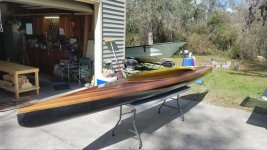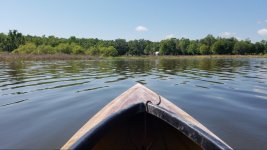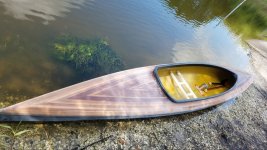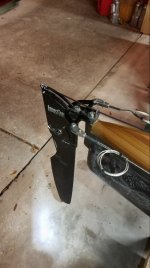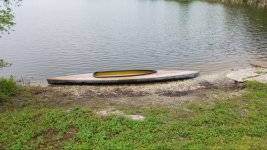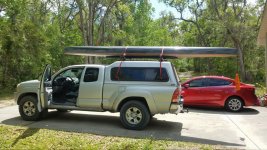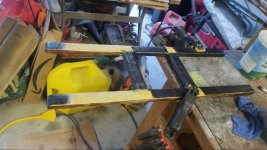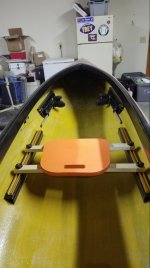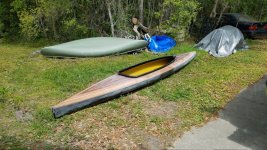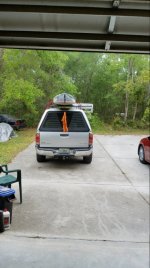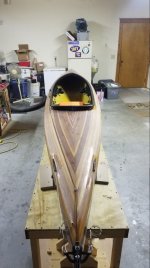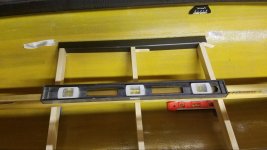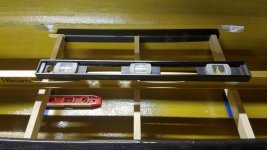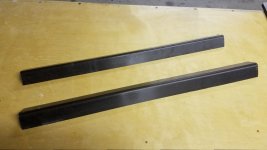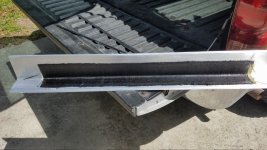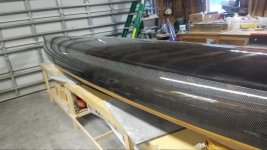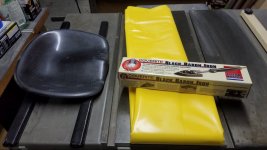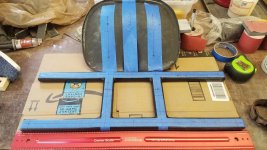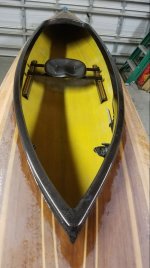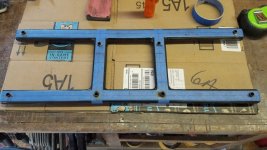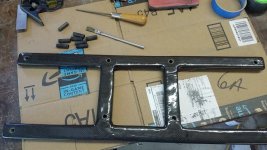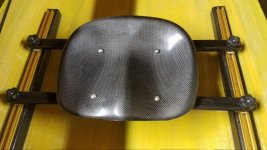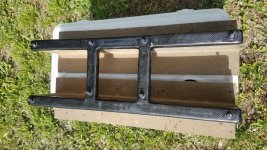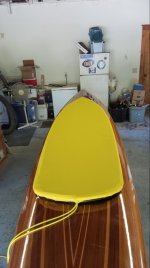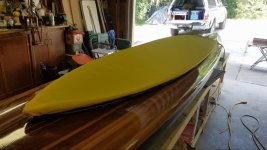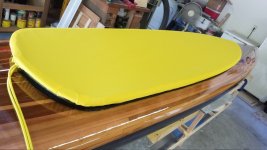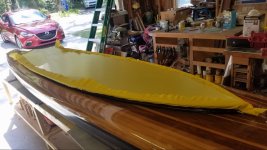Hi gang, been busy like hell, life, work, hurricane Irrma and trying to get this dang canoe built in time for watertribe ec challenge in a few weeks now and haven't been posting or lurking much, here or anywhere else. Didn't quite get to where I needed to be by EC registration deadline though, so won't be entering the challenge this year... Naturally, these projects tend to take longer than we figure, but in my case hurricane Irma damage set me back a few weeks and an unplanned 2 week business trip to Phoenix last month pretty much killed my momentum to finish this thing off. After some prodding I posted the album link the other day on watertribe, but wanted to get something on here since you guys are a lot more into the nuts and bolts of building these things and hopefully end up with a far more interactive and interesting discussion.
Enough grousing, lets get to it...
For the impatient here's the link to some photo's, not all but enough to get a sense of the process from the beginning to where I am now, which is laminating inside hull and deck after some dry fitting and initial fairing. Then I'll be on to rigging smart track foot controls and rudder, seat system yet TBD, then final fairing, uv coating and more sanding and buffing etc... https://www.flickr.com/photos/155383202@N07/albums/72157690391442752
For a little background on my experiences, I've been involved in all sorts of boat projects since the mid 70's, mostly restorations and fiberglass mold repairs, even worked for a prominent S. Fl small boat manufacturer for a few years in the mid 90's. I've done a lot of woodworking from wood longbows to kitchen cabinets, built aluminum airboats from scratch, surfboards, swamp buggies, project cars, worked with advanced paint systems starting with Dupont Imron, Ditzler (now ppg), and Awlgrip, etc, etc. Not an expert by any stretch, but have a lot of hands on with all sorts of materials, mostly red-neck endeavors, but never built a strip boat or canoe. Wanted to several times, but the stars never aligned. Recently getting hooked into watertribe and wanting to compete in something I built myself was the catalyst I needed. Having both kids out of the house and in college now helped free up some time too.
Anyway, this has been a lot of fun for me and I now regret not starting one of these years ago. Although I ended up with a bright deck, more on that later, I went into this build with the intention of using modern fabrics for the skins, carbon/kevlar hybrid, carbon/innegra, vectran, etc. This was primarily in the spirit of experimentation, but also for a little more toughness for expedition type durability. It costs 3-4x more than conventional e-glass but given the scale of the project its just a few hundred dollars more, far less than what I'm paying to keep two kids in college.... Another factor is my home stomping grounds along the coast are laden with hard, wave and weather sharpened coral cap rock, and/or that same cap rock encrusted in oysters. Pretty nasty stuff for thin skinned strip canoes and dangerous to even try to wade/walk in, a slight mishap could result in a bad cut or three. So throughout this whole process anytime I had to consider weight vs scratch and puncture resistance I erred on additional material.
More to the build. Before I started I created some 1'x1'x1/4" and 3/16ths cedar strip test panels and applied the various fabrics, 4 & 6oz e and s glass on its own. For the carbon/kevlar and carbon/innegra panels I added a barrier skin of 4oz s-glass. All this to get an idea of the working properties, wet out, fairing and mirror finish challenges, stiffness, puncture and impact characteristics and of course weight.
As an aside, I'm a RAKA fan, their epoxy has worked well for me on various projects and being in the same state I can generally order something before 2pm and still get it the next day at no extra cost. I used their HP 900 medium viscosity as well as the 350 non blushing and UV inhibited resins. All work as advertised and they are very helpful over the phone when needed. I've used West and MAS in the past too, but ended up trying RAKA a few years ago and between the price, performance and fast order turnaround have been with them ever since. For the carbon/innegra and kevlar I used Soller Composites, Jon is a tremendous resource even if he doesn't sell what I'm asking about. David at Sweet Composites equally as helpful. I ordered e and s-glass from them. So those were my 3 main vendors for epoxy and glass...
Using sq ft panels I could easily estimate overall canoe weight with simple multiplication of the 73sq ft hull area too. Along those lines I weighed the panels before and after each lamination, including a few epoxy only steps to test out gassing vs any weight penalty of laminating over dry wood vs pre-soaked wood. Beyond the weight measurements though I'm not set up for any kind of scientific testing, just some hammer strikes, some point loading, bending panels by hand and against my workbench table edges using a modest force and more body weight, etc. Again, mostly redneck engineering to get some idea of what I was dealing with, not a research paper on material science.
To that end, as a baseline I weighed the panels dry and regardless of apparent grain density, they all weighed between 6 and 6.5 oz raw after glue up. After scraping and fairing they dropped about an ounce to around 5.5oz +/-. So for a 73sq ft hull we're looking at about 25lbs in raw wood and glue alone, plus a little more for combing bolster, hardwood stems or any other similar additions. Getting ahead of myself a bit I can say the epoxy and fabric added between 2 and 2.5oz per layer per side for the 5.5-6oz fabrics. So as another rough approximation adding 5.5oz in glass and epoxy doubles the panel weight to 11oz or 50lbs for the canoe.
These numbers jive with Matt's plan estimation of 50-65lb hull weight depending on layup and builder experience, etc. Bottom line is this is a heavy solo canoe and not a lot of wiggle room to lighten it up and still end up with a durable expedition rig. Kruger Sea Winds are in the 65lb realm so there is some merit for comparison here, although the Kruger's not being cored are probably a bit tougher overall since they'll flex more in very hard impacts. They are also 2.5-5x the cost as well.
I wish I could give a definitive conclusion of which material combination I thought was best, but I can't, there's too many variables and objectives to simplify to that extent. In general I can say the e-glass only panels could be broken along the glue lines by hand, wasn't easy, but I could break them, ymmv. Same with 4oz s-glass, 6oz was tougher but still breakable by hand. The s-glass appeared to snap more cleanly than the e-glass too. The e/s-glass panels could easily be violated into the raw wood with modest force behind a dull box cutter/razor knife. I've repaired enough gelcoat on both powered skiffs and canoes to know oysters and a loaded canoe would not fare well with a single layer of glass, especially over time. More glass and/or thickened epoxy barrier is a must if the canoe will be exposed to a lot of hard, pointy scratchy stuff, which this one will...
The carbon/kevlar and carbon/innegra panels I could not break given the same attempts. Again not scientific but some things are obvious enough to know that having concrete numbers with 4+ decimal places of precision is merely background noise. As mentioned above, these panels also had a layer of 4oz s-glass applied on one side as a sacrificial faring and barrier layer to emulate the outside of the hull. Because of the fairing challenges I couldn't see where I would ever use these materials without the extra layer so I tested them that way. The same somewhat dull razor knife did not find bare wood with the hybrids. To be fair though, if the e/s-glass panels had the same extra layer they may have similarly resisted cutting too. In either case, given the incremental material choices we have at our disposal the transition from adequately strong to over built happens quickly.
Moving along, the 5oz 4-harness Kevlar on its own could be broken too, but was noticeably more difficult and being kevlar didn't come apart like the glass panels did. Most know this, but the take away with kevlar is you could take a catastrophic impact and the fabric will most likely hold the pieces together. You'll take on water but probably no gaping hole unless the impacted object was sharp enough to break the fabric too. I would guess this is not likely at typical canoe speeds though, either whitewater or surfing to safety along a hostile coast. I could however get into some wood through the kevlar with the razor knife. Not as easy as it was with the e/s-glass, but I could get in there a bit with some effort.
Being able to cut through the single layer of kevlar partially influenced my decision to go ahead and add the 5.7 oz carbon twill as opposed to covering with high build epoxy primer and a catalyzed urethane top coat. Another consideration was the multi-component paint system would cost a little more than twice what 6yds of 3K carbon twill with epoxy and would not have been as anywhere near as durable. That extra durability of course comes with a weight penalty, which using my 2.5oz per sq ft per side estimate along with hull only sq ft approximation of 50sq ft should add about 7-8lbs give or take.The other thing was the carbon was black and I decided that was the best contrast color against the bright deck and yellow kevlar interior. So between the cost and not having to deal with the highly toxic paint system I went with the carbon...
If I were doing this again with another NorthWind or some other canoe that I didn't care about showing the cedar and was shooting for best strength/weight I'd probably go with the the 5oz kevlar inside and out and add 4oz s-glass below the water line, then high build primer and catalyzed finish over that for UV barrier and bling. I suspect this would only save a few pounds though. As I mentioned above there isn't a lot of room to work with here unless you use a lighter form of wood or core material as well as more judicious material choice and application. Vacuum bagging/infusing too could trim a pound or so as well, but is a bit complicated to do over a 17' male plug. Might try bagging the next one...
Final comment is I probably won't be too responsive over the next few weeks until I'm about done with this dang thing, which is largely why I haven't posted about it from the outset, I knew I was in a nearly impossible time crunch to make the EC deadline and also knowing my anal retentive nature I'd be on here responding and explaining stuff instead of stripping and sanding.
Knowing this crowd too I'm sure there are some things I missed or didn't think of or could have done differently/better too. Regardless all comments welcome, critical or otherwise.
- eric
Enough grousing, lets get to it...
For the impatient here's the link to some photo's, not all but enough to get a sense of the process from the beginning to where I am now, which is laminating inside hull and deck after some dry fitting and initial fairing. Then I'll be on to rigging smart track foot controls and rudder, seat system yet TBD, then final fairing, uv coating and more sanding and buffing etc... https://www.flickr.com/photos/155383202@N07/albums/72157690391442752
For a little background on my experiences, I've been involved in all sorts of boat projects since the mid 70's, mostly restorations and fiberglass mold repairs, even worked for a prominent S. Fl small boat manufacturer for a few years in the mid 90's. I've done a lot of woodworking from wood longbows to kitchen cabinets, built aluminum airboats from scratch, surfboards, swamp buggies, project cars, worked with advanced paint systems starting with Dupont Imron, Ditzler (now ppg), and Awlgrip, etc, etc. Not an expert by any stretch, but have a lot of hands on with all sorts of materials, mostly red-neck endeavors, but never built a strip boat or canoe. Wanted to several times, but the stars never aligned. Recently getting hooked into watertribe and wanting to compete in something I built myself was the catalyst I needed. Having both kids out of the house and in college now helped free up some time too.
Anyway, this has been a lot of fun for me and I now regret not starting one of these years ago. Although I ended up with a bright deck, more on that later, I went into this build with the intention of using modern fabrics for the skins, carbon/kevlar hybrid, carbon/innegra, vectran, etc. This was primarily in the spirit of experimentation, but also for a little more toughness for expedition type durability. It costs 3-4x more than conventional e-glass but given the scale of the project its just a few hundred dollars more, far less than what I'm paying to keep two kids in college.... Another factor is my home stomping grounds along the coast are laden with hard, wave and weather sharpened coral cap rock, and/or that same cap rock encrusted in oysters. Pretty nasty stuff for thin skinned strip canoes and dangerous to even try to wade/walk in, a slight mishap could result in a bad cut or three. So throughout this whole process anytime I had to consider weight vs scratch and puncture resistance I erred on additional material.
More to the build. Before I started I created some 1'x1'x1/4" and 3/16ths cedar strip test panels and applied the various fabrics, 4 & 6oz e and s glass on its own. For the carbon/kevlar and carbon/innegra panels I added a barrier skin of 4oz s-glass. All this to get an idea of the working properties, wet out, fairing and mirror finish challenges, stiffness, puncture and impact characteristics and of course weight.
As an aside, I'm a RAKA fan, their epoxy has worked well for me on various projects and being in the same state I can generally order something before 2pm and still get it the next day at no extra cost. I used their HP 900 medium viscosity as well as the 350 non blushing and UV inhibited resins. All work as advertised and they are very helpful over the phone when needed. I've used West and MAS in the past too, but ended up trying RAKA a few years ago and between the price, performance and fast order turnaround have been with them ever since. For the carbon/innegra and kevlar I used Soller Composites, Jon is a tremendous resource even if he doesn't sell what I'm asking about. David at Sweet Composites equally as helpful. I ordered e and s-glass from them. So those were my 3 main vendors for epoxy and glass...
Using sq ft panels I could easily estimate overall canoe weight with simple multiplication of the 73sq ft hull area too. Along those lines I weighed the panels before and after each lamination, including a few epoxy only steps to test out gassing vs any weight penalty of laminating over dry wood vs pre-soaked wood. Beyond the weight measurements though I'm not set up for any kind of scientific testing, just some hammer strikes, some point loading, bending panels by hand and against my workbench table edges using a modest force and more body weight, etc. Again, mostly redneck engineering to get some idea of what I was dealing with, not a research paper on material science.
To that end, as a baseline I weighed the panels dry and regardless of apparent grain density, they all weighed between 6 and 6.5 oz raw after glue up. After scraping and fairing they dropped about an ounce to around 5.5oz +/-. So for a 73sq ft hull we're looking at about 25lbs in raw wood and glue alone, plus a little more for combing bolster, hardwood stems or any other similar additions. Getting ahead of myself a bit I can say the epoxy and fabric added between 2 and 2.5oz per layer per side for the 5.5-6oz fabrics. So as another rough approximation adding 5.5oz in glass and epoxy doubles the panel weight to 11oz or 50lbs for the canoe.
These numbers jive with Matt's plan estimation of 50-65lb hull weight depending on layup and builder experience, etc. Bottom line is this is a heavy solo canoe and not a lot of wiggle room to lighten it up and still end up with a durable expedition rig. Kruger Sea Winds are in the 65lb realm so there is some merit for comparison here, although the Kruger's not being cored are probably a bit tougher overall since they'll flex more in very hard impacts. They are also 2.5-5x the cost as well.
I wish I could give a definitive conclusion of which material combination I thought was best, but I can't, there's too many variables and objectives to simplify to that extent. In general I can say the e-glass only panels could be broken along the glue lines by hand, wasn't easy, but I could break them, ymmv. Same with 4oz s-glass, 6oz was tougher but still breakable by hand. The s-glass appeared to snap more cleanly than the e-glass too. The e/s-glass panels could easily be violated into the raw wood with modest force behind a dull box cutter/razor knife. I've repaired enough gelcoat on both powered skiffs and canoes to know oysters and a loaded canoe would not fare well with a single layer of glass, especially over time. More glass and/or thickened epoxy barrier is a must if the canoe will be exposed to a lot of hard, pointy scratchy stuff, which this one will...
The carbon/kevlar and carbon/innegra panels I could not break given the same attempts. Again not scientific but some things are obvious enough to know that having concrete numbers with 4+ decimal places of precision is merely background noise. As mentioned above, these panels also had a layer of 4oz s-glass applied on one side as a sacrificial faring and barrier layer to emulate the outside of the hull. Because of the fairing challenges I couldn't see where I would ever use these materials without the extra layer so I tested them that way. The same somewhat dull razor knife did not find bare wood with the hybrids. To be fair though, if the e/s-glass panels had the same extra layer they may have similarly resisted cutting too. In either case, given the incremental material choices we have at our disposal the transition from adequately strong to over built happens quickly.
Moving along, the 5oz 4-harness Kevlar on its own could be broken too, but was noticeably more difficult and being kevlar didn't come apart like the glass panels did. Most know this, but the take away with kevlar is you could take a catastrophic impact and the fabric will most likely hold the pieces together. You'll take on water but probably no gaping hole unless the impacted object was sharp enough to break the fabric too. I would guess this is not likely at typical canoe speeds though, either whitewater or surfing to safety along a hostile coast. I could however get into some wood through the kevlar with the razor knife. Not as easy as it was with the e/s-glass, but I could get in there a bit with some effort.
Being able to cut through the single layer of kevlar partially influenced my decision to go ahead and add the 5.7 oz carbon twill as opposed to covering with high build epoxy primer and a catalyzed urethane top coat. Another consideration was the multi-component paint system would cost a little more than twice what 6yds of 3K carbon twill with epoxy and would not have been as anywhere near as durable. That extra durability of course comes with a weight penalty, which using my 2.5oz per sq ft per side estimate along with hull only sq ft approximation of 50sq ft should add about 7-8lbs give or take.The other thing was the carbon was black and I decided that was the best contrast color against the bright deck and yellow kevlar interior. So between the cost and not having to deal with the highly toxic paint system I went with the carbon...
If I were doing this again with another NorthWind or some other canoe that I didn't care about showing the cedar and was shooting for best strength/weight I'd probably go with the the 5oz kevlar inside and out and add 4oz s-glass below the water line, then high build primer and catalyzed finish over that for UV barrier and bling. I suspect this would only save a few pounds though. As I mentioned above there isn't a lot of room to work with here unless you use a lighter form of wood or core material as well as more judicious material choice and application. Vacuum bagging/infusing too could trim a pound or so as well, but is a bit complicated to do over a 17' male plug. Might try bagging the next one...
Final comment is I probably won't be too responsive over the next few weeks until I'm about done with this dang thing, which is largely why I haven't posted about it from the outset, I knew I was in a nearly impossible time crunch to make the EC deadline and also knowing my anal retentive nature I'd be on here responding and explaining stuff instead of stripping and sanding.
Knowing this crowd too I'm sure there are some things I missed or didn't think of or could have done differently/better too. Regardless all comments welcome, critical or otherwise.
- eric

